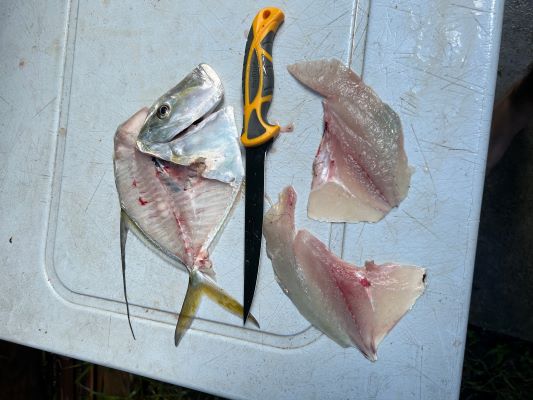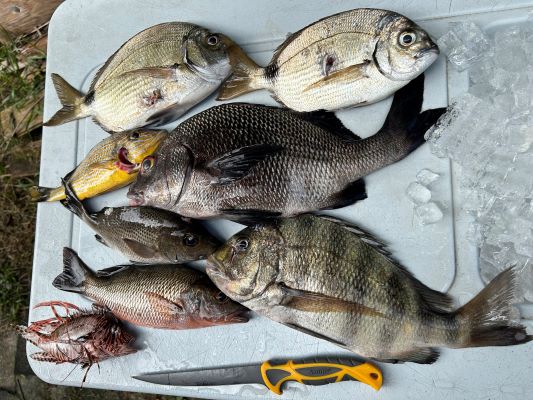
Written by Christian Valdez, AAF Projects Director
As a native Floridian, and especially one who enjoys time out on the water, I have become very familiar with the effects of our intense climate on a day to day basis. With this in mind, some of the official (unofficial) side effects of a perfect day out on the water may be extreme thirst, chaffing, sunburn, and a deep lack of motivation for the rest of the day once you get home.
After a day of productive fishing, however, there’s one last hurdle you must cross before putting your feet up- the fish have to be fileted. Now, I’m not sure about you, but at this point in the day I’m about ready to get this done as efficiently as possible- I don’t want to waste any of that precious meat, but at the same time every little second saved is one closer to me grabbing a beer and throwing on an episode of whatever I’m in the mood for.
It may not seem like a big deal to those who haven’t spent hours filleting fish before, but a boat full of lucky anglers can clear quite a haul of fish (check your bag limits folks). Practically, this is something that a commercial charter captain has to deal with on a daily basis. For the average recreational angler, these days can be rare, so while the former might sensibly invest in very expensive fillet knives, us recreational folks would be wise to find a well-priced knife that comfortably gets the job done.
Simply put, the difference between the greatest fillet knife and a really good fillet knife is much less noticeable than the difference between that same really good fillet knife and a low-quality fillet knife. Those who have experience with a wide range of fillet knives can tell a difference between the poorly made and well-crafted one fairly quickly. Cheap manufacturers can cut corners on everything from the shape of the handle, the materials used, the sharpness of the blade/quality of metal, and other aspects of the product. These shortcomings can have a noticeable effect on how precisely, quickly and safely you can take fillets from your catches- and I don’t know about you, but after a day on the water, the last thing I want to do is spend more time filleting than I have to.
Luckily, I’ve run into an amazing fillet knife that feels and cuts like one of the best, but at a price point that makes it attainable for us recreational anglers. For my money, Smith’s Lawaia 7” fillet knife is the perfect addition to any recreational fisherman’s arsenal, no occasion necessary (although they also make great birthday gifts).
Right off the bat, the 7-inch version has a blade perfect for gliding down the vertebrae of your keeper catch. If you spend any amount of time targeting Snapper, Trout, Sea Bass, or other small to mid-size fish, you covet a highly maneuverable blade with the ability to precisely control exactly where you’re cutting, which allows you to retain the most meat possible from smaller fish. The 7-inch Lawaia does this in spades. Don’t get it twisted though- this knife tackles bigger catches just as easily. The scarily sharp, stainless-steel blade is stiff enough to carve through highly durable scales without the fear of much meaningful resistance. With a 9-inch version also out on the market, there are options for any situation you might run into- I prefer this longer version for those larger catches and sometimes skinning the smaller fillets.
What’s more, the handle is both shaped and textured in a way that reduces slipping- unless you’re being extremely reckless, there should be almost no risk of making the wrong move and losing a finger. This goes for those occasions when you’re dealing with the slimiest of fish-here’s looking at you, previously mentioned Spotted Sea Trout.

AAF Executive Director Brett Fitzgerald is familiar with the blade, and he agrees. “The 7-inch Lawaia quickly became my go-to fillet knife. The steel is stronger than most less expensive knives, so it sharpens fairly quickly yet holds an edge exceptionally well. At the same time, it has just enough flex so I can really get tight to the spine and ribs. So far, it handles panfish to 30-pound mahi like a champ. It even tames sheepshead, which have dulled many fillet knives over the years.”
The last aspect of the knife that I get really excited about is the sheath that’s included with every knife, straight from the package. Since it’s so sharp, there’s no way you want to leave the blade unsecured when not in use. No matter if you have a special place in your home where you keep your fillet knives, or you like to let them float around your boat for easy access once you get back to shore, it’s always a good idea to keep you or others from any accidental exposure to the blade, not to mention protecting the edge on your blade. This sheath is made from hard plastic but is vented all along the blade which will help keep it dry once stored. Not every fillet knife manufacturer includes such a smart sheath to their products, so it’s just another way that Smith’s outclasses their competitors with no extra cost to you.
Speaking of cost, this knife retails around $30-$40, depending on the length of the blade and where you buy it. Amazon, Walmart, Smith’s own website, and other online retailers all currently sell this product.
This review is not endorsed by Smith’s- they did not ask me to review this product, nor will I benefit monetarily from this review once it is published. I simply liked the quality of the knife and felt compelled to share with our members and readers exactly why. Next time you are in the market, give it a look.
